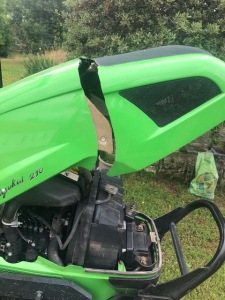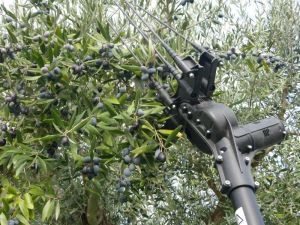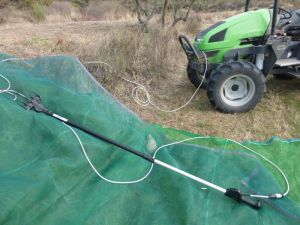About two years ago I opened the bonnet (hood) of my tractor and it felt very heavy, the gas strut which pushes it up had failed. When the tractor was next serviced I asked the local mechanic if he would replace the support, which he did. Two days after the tractor returned I was mowing an olive grove when BANG the bonnet jumped forward and when I investigated the strut had pushed its mounting so hard that it had sheared it off under the bonnet, which is thick plastic. The mechanic said it would be a tricky repair, why not just carry a stick around to jam the hood open? Which I did.
Eighteen months later, May 2020, the engine developed a fault and I had a different mechanic from a main dealership come to investigate. On Tuesday he took the tractor away for repair and servicing, and incidentally to replace the gas strut mounting so it could work again. He brought it back on Thursday, all done. That evening I noticed a one-inch crack at the air vent cutaway in the plastic bonnet, so decided to keep an eye on it. On Friday morning I opened the garage and the crack had grown to a ten-inch break almost across half the bonnet, clearly serious and possibly difficult to repair. I rang the main dealer who said don’t worry, just carry on and disconnect the strut if you can, which I couldn’t. I sent them a picture of the breakage, and tried using gaffer tape on it.
Out mowing the same olive grove as two years ago BANG and the bonnet jumped forward, but this time the strut had forced it apart almost into two, a serious breakage now. I sent the garage another picture and spoke with them. They asked me to remove the strut altogether by any means, and then to remove the bonnet completely, which I couldn’t as it was almost in two parts and now fragile. The same mechanic came to remove it and take it in for repair or replacement. I thought this part would cost around two hundred euros, an expensive strut this was turning out to be.

The next day I rang them and their office said they were looking for a replacement and would send me an estimate. This was their reply
Hi. Mr. Clive,
So… There is one in Germany, that can be sent to Portugal, the cost will be 1040€ with TVA included, but they cannot guarantee that it is already painted, if not, the value adds..
My coworker said if you can bring it in here so we can see if we can fix it and how much it costs..
Best regards,
Apresento os melhores cumprimentos,
Patricia Mendes
The mechanic who now has the broken bonnet said the price is exorbitant. So we wait to see if they can effect a repair . . . Wish I’d just carried on using the stick.












